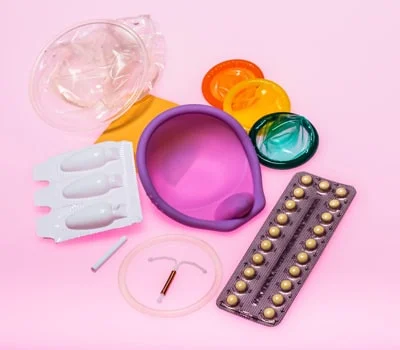All Departments
- PCOS Treatment
- STD Treatment
- Infertility Treatment
- Fibroid Treatment
- Endometriosis Treatment
- Ovarian Cyst Treatment
- Sexual Dysfunction
- Menopause Specialist
- Irregular Menstrual
- Laparoscopic Gynecologists
- Hysterectomy
- Urogynecologist
- Contraception
- Colposcopy
- AMH Testing
- O Shot
- G shot Treatment
- Vaginoplasty
- labiaplasty
- Clitoral Hoodectomy
- Vaginal Bleaching
- High-Risk Pregnancy
- Pregnancy Care
- Maternal Fetal Medicine
- Cesarean Delivery
- Painless Normal Delivery

Contraception
What is Contraception?
Contraception can be a method or device used to prevent pregnancy. It is also known by names like birth control, anticonception, or fertility control.
Types of Contraception
There are different types of contraception as per the need and suitability. Choosing the most appropriate method would depend on factors like age, overall health, desire to have a child later, frequency of intercourse, number of partners, and family medical history.
- Sterilization
- Emergency
- Contraception
- Barrier Methods
- Hormonal Methods
- Long Acting Reversible
- Contraception

Benefits of IUDs
Convenience – No preparation, daily reminders required.
No maintenance – Once inserted, it does not require any maintenance.
Effective – Both copper and hormonal IUDs are more than 99% effective at preventing pregnancy.
Easier periods – An option for those who suffer from heavy and difficult periods.
Long lasting – The instruments work for 3 up to 12 years. Mirena can last for 5 years, and the copper IUD can last for 10 years.
Reversible – Easy to remove when you wish to get pregnant, and you can start to try conceiving right away.
Patient satisfaction – Women do not feel any discomfort. No medications stop them from working.
IUD Insertion
An expert physician inserts the IUD by holding the slider firmly at the top of the handle and gently placing the inserter into the cervical canal. Some doctors believe that woman’s menstrual period is the best time for inserting an IUD, as the cervix is dilated at that time. IUD insertion is also performed to help reduce severe menstrual pain and problems related to the abnormal growth of uterine-lining tissue.
IUD Removal
IUD removal process is quick and simple, just the reverse of insertion. If you are looking for IUD removal, a healthcare provider tenderly pulls on the string to fold the arms of the device, and it slips out easily. Some women feel a cramp for that moment but feel normal in a few minutes.

